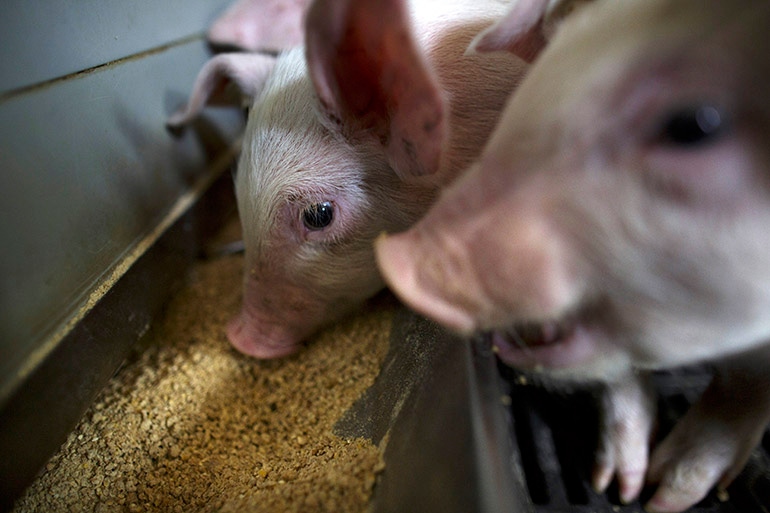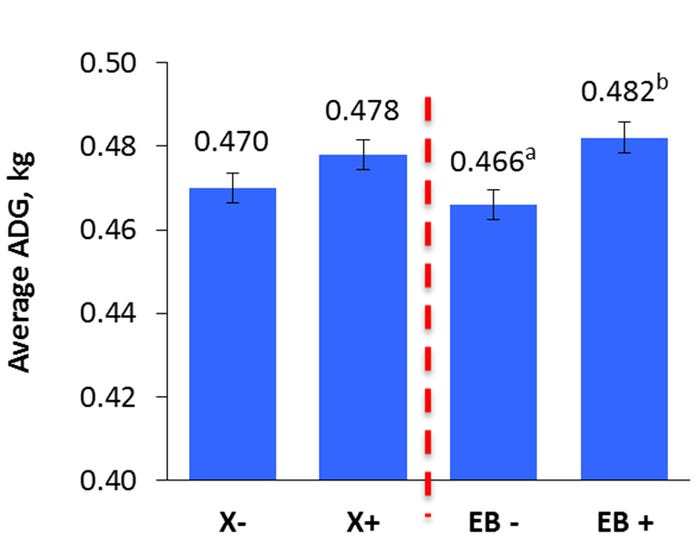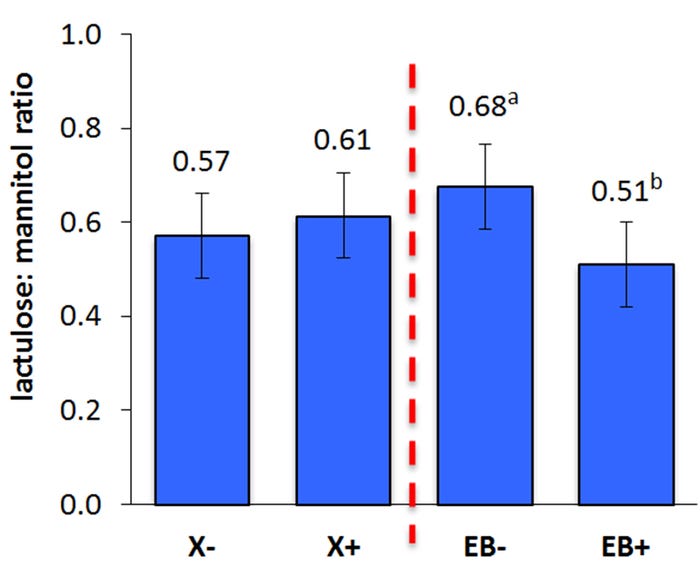Fiber-degrading enzyme cocktail improved pig’s gut health as well as growth performance in the nursery
Fiber-rich ingredients such as DDGS and wheat middlings are usually co-products from grain milling or processing industries; thus they are often more cost-effective than their parent cereal grains.
November 22, 2017

By Q.Y. Li, N.K. Gabler and J.F. Patience, Iowa State University Department of Animal Science; C.L. Loving, USDA-ARS-National Animal Disease Center; and J.C. Sparks Huvepharma Inc.
Corn and wheat are two of the most common basal energy sources used in swine diets in North America. However, due to the high cost of energy in pig diets, the use of high-fiber ingredients, such as distillers dried grains with solubles and wheat middlings, has increased. Those fiber-rich ingredients are usually co-products from grain milling or processing industries; thus they are often more cost-effective than their parent cereal grains.
However, pigs cannot digest fiber very well. Most fiber in the pig’s diet comes from complex carbohydrates that make up the cell wall of many plants. These cell walls contain cellulose and hemicellulose; the former is undigestible to the pig and cannot be fermented by bacteria living in the pig’s small intestine while the latter is undigestible to the pig but can be fermented to some extent. Of great importance to the pig is the fact that some essential nutrients such as protein and minerals are trapped within these cell walls, and thus cannot be used by pigs — unless those cell walls can be broken down.
Dietary fiber has another negative effect on the pig; it increases losses of amino acids from the gut by physical abrasion of the mucosal layer of the intestines. Additionally, some types of fiber can increase the passage rate of diets through the digestive tract, reducing the time available for digestion to occur. Therefore, high inclusion rates of fibrous ingredients in swine diets is often associated with decreased nutrient utilization and low net energy values; when this happens, growth rate is reduced.
Supplementation of fiber-degrading enzymes (carbohydrases) in the diet may mitigate the negative effects caused by dietary fiber. Carbohydrases can help animals break down the fiber components in the plant cell walls, thus releasing the entrapped nutrients (e.g. proteins), making them more available for digestion. By breaking down these call walls, which are made up of very long, undigestible chains of sugars, enzymes may also release individual sugars which the pig can use as an energy source. The partial breakdown of these undigestible chains may also promote gut health by stimulating the growth of beneficial bacteria while inhibiting pathogenic bacteria in the gut. This may in turn reduce the immunological and energetic burden on the growing pig, making nutrients and energy available for growth.
However, information regarding the impacts of enzyme supplementation on immune status and gut health in weaned pigs is limited. Moreover, the effects of these carbohydrases on nutrient digestibility and growth in pigs have been inconsistent. It is common to observe improvements in nutrient digestibility, but not growth performance, which indicates not all of the absorbed nutrients are used for muscle growth. The evaluation of how dietary carbohydrases affect gut health and immune status along with growth performance can help us better understand the mode of action of carbohydrases and help producers strategically utilize them in pig diets. For example, with increasing pressure on the use of antibiotics in the feed, it would be helpful to the pork industry to be able to design nursery diets that encourage improved gut health in the pig.
Therefore, our group conducted an experiment to evaluate the effects of dietary xylanase (X; Hostazym X, Huvepharma Inc.) and an enzyme blend (EB: cellulase, ß-glucanase, and xylanase; Hostazym DDGS, Huvepharma Inc.) on immune status, gut barrier integrity and growth performance in weaned piglets fed a low-energy diet (ME: 3.35 and 3.29 megacalorie per kilogram and NE: 2.43 and 2.37 megacalorie per kilogram for weeks 1-2 and 3-4, respectively). A total of 460 pigs (6.43 ± 0.06 kilogram bodyweight; F52 Gentaporc × 6.0 Gentaporc) were randomly blocked by weight and assigned to four treatments in a 2 × 2 factorial arrangement: xylanase (0 vs 0.01%) and EB (0 vs 0.01%). There were 12 pens assigned to each treatment. The diets were based on corn, soybean meal, corn DDGS and wheat middlings (5 and 10% each fiber ingredient for weeks 1-2 and 3-4, respectively).
There were no interactive effects between X and EB for all growth parameters. The EB addition, but not xylanase, significantly improved average daily gain (Figure 1) and body weight from weeks 1-4. The EB increased small intestinal integrity as assessed by a decrease in gut leakiness in the in vivo assessment of urinary lactulose:mannitol ratio (Figure 2). Improved small intestinal integrity is often associated with better gut health and function, preventing pathogens or toxins from entering the body from the intestinal tract. Additionally, EB increased the mRNA abundance of claudin 3 (a tight junction protein) in the small intestine, which also suggests EB is improving small intestinal barrier integrity in nursery pigs. From Day 0-28, X decreased IL-1ß and EB reduced IL-8 levels in the blood, indicating a decreased immune activation status.

Figure 1: The impact of xylanase (X) and an enzyme blend (EB) on average daily gain across four weeks in nursery pigs Note: Means with different superscript letters differ (P < 0.05)

Figure 2: The impact of xylanase (X) and an enzyme blend (EB) on lactulose:mannitol ratio (gut leakiness or barrier integrity indicator) in nursery pigs. Note: Means with different superscript letters differ (P < 0.05)
In conclusion, both carbohydrases may have decreased peripheral inflammatory status, which potentially saves energy for muscle growth. The enzyme blend also improved growth rate in nursery pigs fed a lower-energy, higher-fiber diet, which may be mainly due to improved gut health and reduced immune activation. To our knowledge, this is the first time that a growth response was observed concurrent with improved gut barrier integrity by adding dietary carbohydrases in pigs. This may help to explain the observations by some producers that xylanase may reduce mortality in wean-to-finish barns.
Implication: The addition of a fiber-degrading enzyme blend in nursery diets may be used to promote gut health and improve growth performance.
You May Also Like



